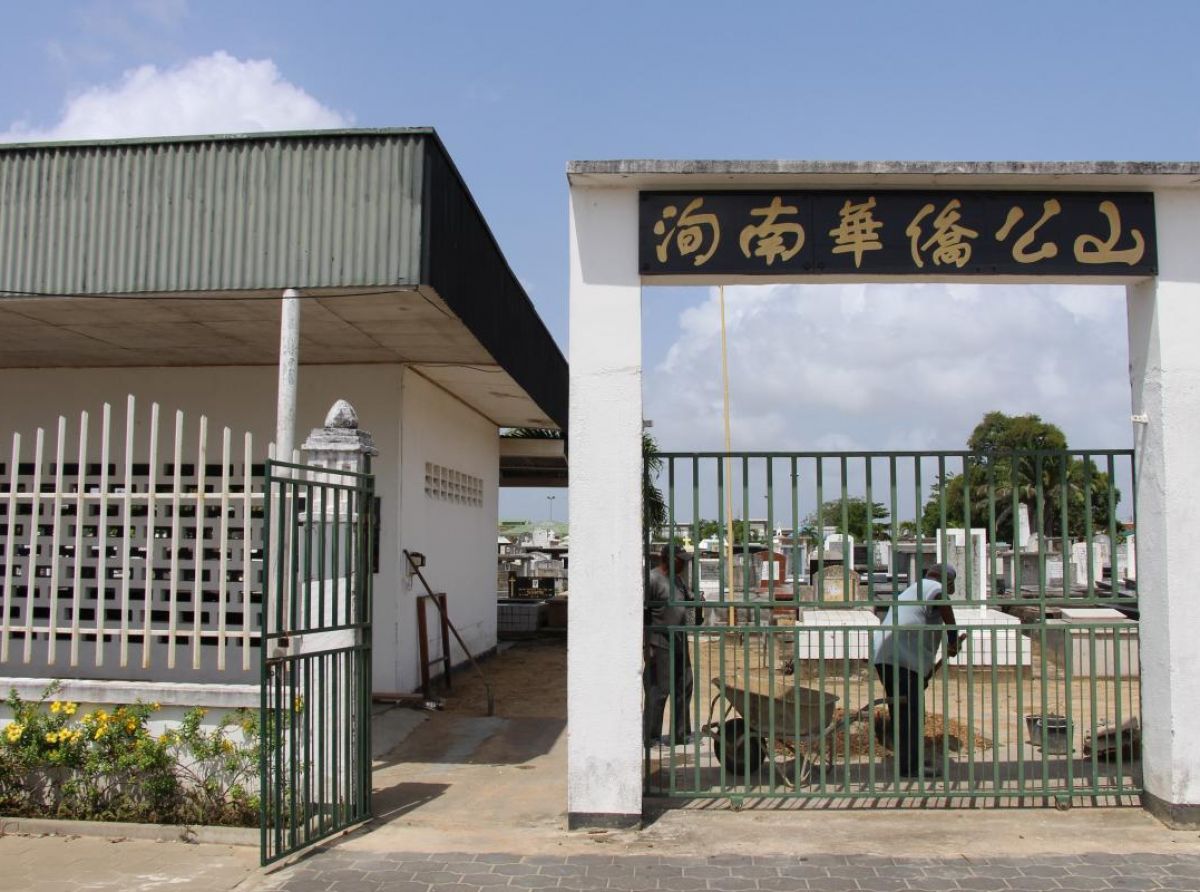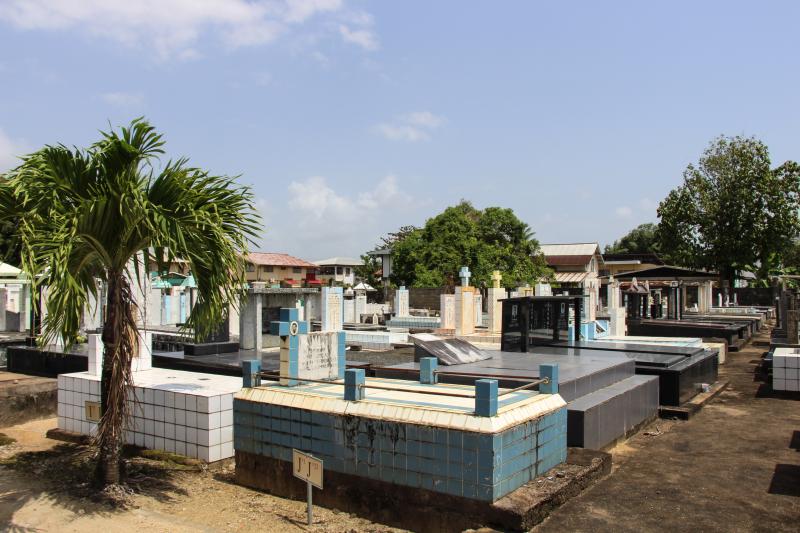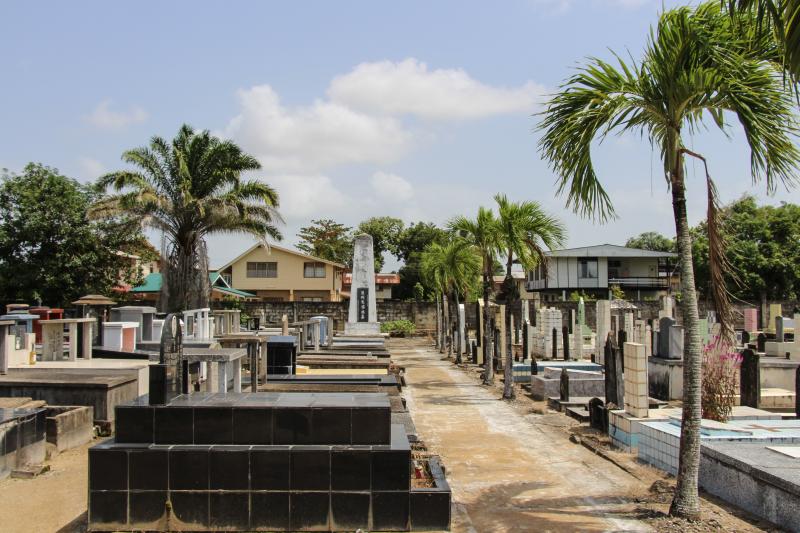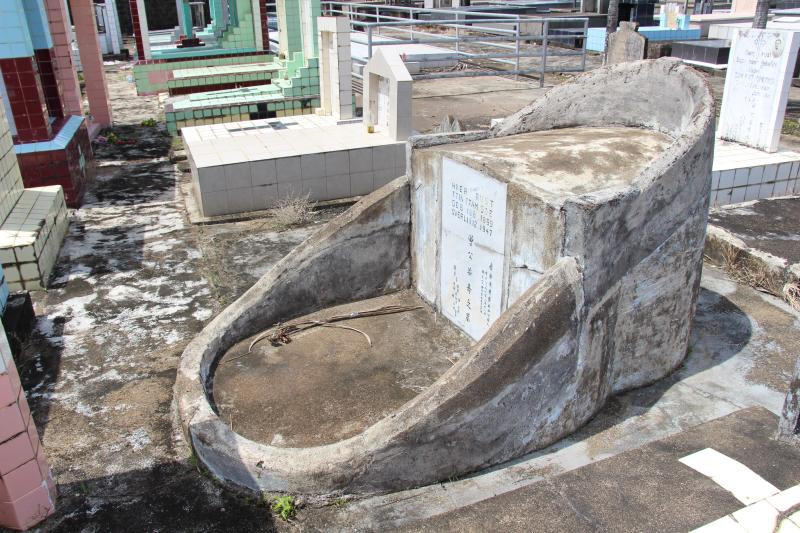
Fa Tjauw Koen Sang
The history of a cemetery for Chinese residents of Paramaribo goes back to the late nineteenth century. Just before the turn of the century, the Kong Ngie Tong Association established a final resting place for the Chinese community. People would be buried there for over forty years.
Old cemetery: Kong Ngie Koen Sang
The Kong Ngie Tong association established a cemetery in its own name in 1890 on a plot on the corner of Wanicastraat and the road besides de Steenbakkersgracht (now Dr. Sophie Redmondstraat). The cemetery on domain grounds was closed due to full utilization of its capacity in the 1940s. No documents or data of any kind have been left behind. There is a persistent rumor that their tombstones have been used as tiles for the garden path of the Grote Stadskerk on Steenbakkerijstraat next to Kersten & Co. [Ed. This rumor may have been fueled by the fact that some grave monuments of the former EBGS cemetery Christina's Rust have been placed behind the Grote Stadskerk]. After the graves had been cleared, the plot remained vacant for thirty years according to the old law until it was issued at her request in the early 1970s to the Kong Ngie Tong Sang Association as successor to the disbanded Kong Ngie Tong. A new storey building was erected on the plot in 1979 for a cultural center, which also houses a Chinese school (KNT-Gedenkboek: 59)
New Cemetery: Fa Tjauw Koen Sang
A committee of a workgroup[1] led by members Woei A Tsoi, Lie Kam and Liu YuSen, 1944 was charged with the task of finding a location for a new cemetery. The diocese of the Roman Catholic Church was willing to rent a parcel of land to the Chinese community opposite its own cemetery on Schietbaanweg. A period of 100 years would have been agreed for this (KNT-Gedenkboek: 59). The site that was taken into use as a cemetery in 1945, was divided in two parts: right of the entrance should be reserved for parishioners of the Roman Catholic congregation and left was destined for followers of other faith groups. This policy is no longer applied.
 Overview (Photo René ten Dam, 2017)
Overview (Photo René ten Dam, 2017)
The three Chinese Associations: Kong Ngie Tong Sang, Chung Fa Foei Kon and Fa Tjauw Song Soei, part of the Fa Tjauw Koen Sang Foundation, acquired ownership of the plot at the beginning of this century. Sale and transfer of the land by the R.K. Foundation "Founded of the Charity under the name of Providence" took place on August 2, 2006 in the presence of civil-law notary Mr. C.A. Calor.
Of the more than 100 cemeteries in Suriname, the last resting place of the Chinese in Paramaribo of more than 0.8 ha can be counted in the category of smaller graveyards in private hands. (cf. Encyclopedie van Suriname: 52/53)
Land size and absorption capacity have recently ceased to play a predominant role in the continued existence of a cemetery in Suriname.
A 2007[2] law change makes it possible that administrators are allowed to clear older graves from the age of twenty if there is a threat of overcrowding, so that closure is not the only option. In this way, cemeteries can certainly retain their destination for a long time, if not forever. After an initial term of twenty years, an extension of the burial right can be applied for each time for a period of ten years.
Chinese names and concepts in Surinamese-Hakka with in square brackets the pronunciation and transcription into Mandarin in Pinyin:
- Ching Ming Tjit [= Qing Ming Jie]: spring festival of the 5th day of the 5th month (lunar calendar);
- Chung Fa Daily: [ ZhongHua RiBao];
- Chung Fa Foei Kon [= Zhonghua HuiGuan]: Chinese association;
- Fa Tjauw Koen Sang [HuaQiao GongShan]: new cemetery; − Fa Tjauw Song Foei [= Huaqiao ShangHui]: Chinese association;
- Kazan [= GuaShan]: Chinese remembrance day, a form of All Souls' Day;
- Kong Ngie Koen Sang [= GuangYi GongShan]: old Chinese cemetery;
- Lidai Xianqiao Zongmu: bet.: Central Grave Monument of Our Historical Ancestors;
- SunLam Fa Tjauw Koen Sang [= SunNan Huaqiao Gong- Shan]: Sranan Chinese cemetery;
- Tsung Yong Tjit [= Chong Yang Jie]: autumn festival of the 9th day of the 9th month (lunar calendar);
Remembrance of the dead and adaptation
In China, deceased relatives are commemorated twice a year, whereby the graves of parents and ancestors are cleaned up and sacrifices are made. The Ching Ming [QinMing] Festival is celebrated in the spring and the Tsung Yong [Chong Yang] Festival on the Ninth Day of the Ninth Month in the autumn.[3] Victor Burckhardt (1966: 134) confirms that a memorial service is held twice a year in Hong Kong: ‘They [i.e. graves] are tended twice a year, at Ch’ing Ming in the spring, and on the 9th of the Ninth Moon in the autumn.’[4]
The Chong Yang Festival of the Ninth day of the Ninth month is traditionally celebrated with ‘Autumn outing and mountain climbing, [while] some Chinese also visit the graves of their ancestors to pay their respects.’ In China en Taiwan wordt inmiddels een gewijzigde betekenis en inhoud toegekend aan de viering van het festijn. Because ‘In 1966, the Republic of China (Taiwan) rededicated the holiday as ‘Senior Citizens’ Day’, underscoring one custom as it is observed in China, where the festival is also an opportunity to care for and appreciate the elderly’. (Wikipedia: Double Ninth Festival). Following this, in 1989, the People's Republic of China identically designated the Chong Yang Festival as "Senior's Day". (www.travelchinaguide.com).[5]
Surinamese Kazan with its own character
In Suriname, relatives who have died are commemorated jointly only once a year, where libations are brought and the graves of (ancestors) parents are cleaned and cared for. The purpose of the festival was to commemorate their own (ancestors) parents on that occasion and to provide them with everything necessary for use in the hereafter.
The Tsung Yong festival known to Hakkanese as Kazan was traditionally a family celebration, but has become a historical event locally.[6]
That Chinese immigrants had previously opted for only one joint commemoration of the dead per year, namely for the Tsung Yong celebration in the autumn, according to a report in the Suriname newspaper of 23 October 1928, which referred to a 'Chinese sacrificial feast'. at the 'Chinese cemetery Mariusrust ...' [Ed. This will be Willems Rust, as the cemetery was also called. Marius Rust is located further down Sophie Redmond Street and belongs to the EBGS]. Incidentally, no further details were given in the short report.
However, the concept of the Tsung Yong commemoration has gradually changed and broadened in form and content. The aim is now to give this solemn and festive occasion the character of a general manifestation and to make it accessible to more and other groups in society. Because of this development, the private and intimate ritual in a family context has gradually been abandoned for a more elaborate tribute to all ancestors. See an announcement in the morning paper De Ware Tijd voor Kazan 1996. (Zijlmans&Enser, 2002: 131)
In order to give shape and meaning to a collective Kazan commemoration, a meters high column was erected as early as 1945 as a central point where the usual offering can be made during the prescribed ceremonies. The inscription of the monument is telling: "Lidai xianqiao zhongmu", meaning "Central Funeral Monument of Our Historical Ancestors". But for the many traditionally loyalists, the day is reserved for taking care of (ancestral) parental graves of their own family.
Official recognition
However, the celebration of 2012 was given a special cachet by the participation of the Ambassador of the People's Republic of China, on which occasion, according to a colorful report by Edward Troon (Star News: 23-10-2012), the following activities took place: 'With at least a flower in hand, hundreds of Chinese today honor their ancestors. During the annual Chinese ancestor worship "Kazan", tombs are cleaned, candles and incense burned, paper clothing and counterfeit banknotes burned, and fireworks set off. Meat dishes, fruit and drinks are also not missing during the offering. In addition to dozens of families, the Surinamese Chinese Societies and the Chinese ambassador and his staff have paid their respects at the collective grave and monument at the Fa Kiao Kun San (Chinese) cemetery. The collective grave mentioned here concerns the remains of the cleared graves of the old Chinese cemetery. It is not clear whether a register of the graves and persons involved exists and where it is kept.
 Overview with monument on the collective grave (Photo René ten Dam, 2017)
Overview with monument on the collective grave (Photo René ten Dam, 2017)
After the ceremony, all offered dishes, food and refreshments are then distributed according to good use among the three Associations for a communal meal in their clubhouse for the respective members and guests.
Cemetery: appearance and design
No communal cemeteries were established in rural areas of southern China. Deceased relatives and especially the (ancestors) parents were laid to rest in selected places on slopes of hills of communal village land, preferably with a wide view and lower water feature. The choice of a favorable place is determined by principles of the fengshui teachings. [7]
The confrontation in the tropics with low-lying terrains, limited space and prescribed placement of one's own relatives between various other, strange souls caused a considerable adjustment of the immigrants.
The design of the tombs furthermore led to an adaptation to local customs and ideas of the prevailing culture in this area, which underwent a development from simple cellars and wooden tombstones to fully cemented constructions with superstructure. Depending on the economic and social circumstances, various materials are used, from a simple cement layer to hard types of stone such as (multicolored) marble, with or without a covering canopy or sometimes with a small chapel. In general, a striking number of unadorned Latin crosses can be found as decoration. A lot of time and effort does not seem to be spent on an artful arrangement. In many cases, a porcelain photograph of the person (s) involved can be affixed to the main wall. There is also a noticeable difference between tombstones created by the "Chinese" family themselves or by the "Surinamese" descendants of deceased migrants. It is customary among Chinese to state on the plaque of the tombstones the necessary biographical data in Chinese script of the (ancestors) involved, and not only the romanized names and the biographical data in Arabic numerals. Family graves have not been found, but graves of married couples have. It is striking that in a number of cases Surinamese women are described next to their partners as of the same Chinese origin.
 Traditional monument (Photo René ten Dam, 2017)
Traditional monument (Photo René ten Dam, 2017)
Condition of maintenance and presentation
Andro Vorswijk, who was appointed around 2000 as supervisor of the complex, told Troon (l.c.) the following about his workplace, not without some pride: "… this is the cleanest and best-maintained cemetery in Suriname. If a grave is damaged, I will fix it immediately. There is also an overview by the map in the auditorium and the signposts along the main path".
Under certain circumstances, the complex of Fa Tjauw Koen Sang does not stand out optically in a disadvantageous manner with other necropolises in terms of presentation and maintenance. In 2015, there were still a few things to note about the clarity and accessibility of the graves. The rather swampy walkways in the rainy season and the unusually fast growing grass in the warm months and dry season, more often threaten to make the more simple graves, that is to say with tombstones without construction, inaccessible.
Comments are often heard from visitors about the deplorable upkeep of the cemetery and the desirability for improvements. However, it should be borne in mind that the board of the Fa Tjauw Koen Sang Foundation consists of volunteers from the three participating associations and that income is only obtained from the (one-off) burial rights and donations for the exploitation of the business. Where appropriate, operating deficits are apportioned by the participating associations.
This article is an edited version of 'Chinese begraafplaats - Fa Tjauw Koen Sang', published in Wi Rutu (2016 - No. 1). Reproduced with permission.
Literature
- Berkowitz, Morris I., Frederick P. Brandauer, John H. Reed. Folk Religion in an Urban Setting. Hong Kong, 1969. Library of Congress Catalog Card Number: 71 - 86967;
- Burckhardt, V.R. Chinese Creeds and Customs. Vol II. 7e dr. Hong Kong, 1966;
- Dijs, Henk G. Tru Tru Brudu. De Nazaten en (Aan)verwanten van Lea Strijdhaftig. Amsterdam, 2004;
- Encyclopedie van Suriname. (Hoofdred.: C.F.A. Bruijning en J. Voorhoeve; samenst.: W. Gordijn). Amsterdam / Brussel. 1972; (ISBN 90 10018423. Lemma: ‘Begraafplaatsen’, p. 52 / 53);
- Kong Ngie Tong. Gedenkboek 1880 -1980 (Chinese tekst), Paramaribo. Geïll.; (Hierna geciteerd als: KNT-Gedenkboek)(In het bijzonder wordt verwezen naar: Chiu Hung & Chow Chi Wo: ‘Van GuangYi Gongshan naar Huaqiao Gongshan’; (p. 59 / 60); Commissie Huaqiao Gongshan: ‘Financiële verantwoording met lijst van con- tribuanten (1976)’; (p. 60 / 65); ‘Commissies van Kong Ngie Tong Sang en Overzicht Bestuur van Fa Tjauw Koen Sang 1967 – 1982’; (p. 117 - 121)
- Man A Hing, William L. ‘Van KONG NGIE TONG naar KONG NGIE TONG SANG: ’n succesvolle doorstart’, in: dagblad De West van 26 augustus 2003, no. 38814. P.7. Paramaribo. (In het bijzonder paragraaf: ‘Laatste rust plaats’);
- Staatsblad (S.B.) Wet van 26 juli 2007, houdende nadere wijziging van de Begrafeniswet 1959 (G.B. no. 117, geldende tekst G.B. 1959 no. 119, zoals laatstelijk gewijzigd bij S.B. 2001 no. 38);
- Zijlmans, G.C. en H.A. Enser. De Chinezen in Suriname. Een geschiedenis van immigratie en aanpassing 1853 - 2000. Barendrecht, 2002. ISBN 90 806 479 3 4. (Hierna geciteerd als: Zijlmans&Enser); (betr.: p. 131: advertentie in DWT (De Ware Tijd) van de Drie Verenigingen voor Kazan 1996: Fa Tjauw Koen San).
Internet
- www.allerzielen.nl (consulted: 27-01-2016);
- http://andersgedenkmonumenten.nl/surinaams-creoolse-grafstenen-grafmonumenten-gedenkmonumenten (consulted: 02-02-2016);
- http://www.china.org.cn/english/features/Festivals/78310.htm (consulted: 07-02-2016);
- http://www.chungfadaily.com/index.html (consulted: 10-09-2015);
- www.issuu.com/janneshmulder/docs/begraafplaatsen_in_ Paramaribo_met_foto’s; betreft: Jannes H. Mulder: Begraafplaatsen van Paramaribo; (consulted: 13- 01-2016);
- www.meertens.knaw.nl/meertensnet/wdb.php? sel=79964; betreft: Allerheiligen (consulted: 05-05-2016);
- http://www.nospang.com/index.php; betr.: Eerste wettelijke grafruiming van 01-12-2009 (consulted: 18-12-2015);
- http://www.starnieuws.com/index.php/welcome/index/nieuwsitem/13637; betreft: Edward Troon: ‘Honderden Chinezen eren hun overleden voorouders’; (consulted: 04-01-2016);
- www.surinaamsegenealogie.nl/; betreft: Wet van 26 juli 2007 SB. no. 9;
- http://www.timeanddate.com/holidays/un/international-older-persons-day; (consulted: 05-05-2016);
- http://www.travelchinaguide.com/essential/holidays/ chongyang.html Chongyang Festival (Double Ninth Festival)(consulted: 06-03-2016);
- https://en.wikipedia.org/wiki/Double_Ninth_Festival. (consulted: 29-01-2016);
- https://nl.m.wikipedia.org/wiki/Chinese_Surinamers (consulted: 19-01-2016);
- https://en.wikipedia.org/wiki/Traditional_Chinese_holidays (consulted: 02-02-2016).
Notes
[1] Workgroup Preparation Chinese cemetery Fa Tjauw Koen Sang (KNT-Gedenkboek: 60): Chang Sing Ngai (K-2); Chang Ting Ying; Chin A Kon (EEE-3); Chin Sie Fat (EEE-5); Jong Tjien Fa (C-1 / E-3); Kong Tse Lam (BBB-28 [O-4 / QQQ-8]); Lee Kon Fong; Lie Kam (M-1); Lie Kon Tja (L-3); Nai Chung Tong (BBB-2); Sjauw Foek Loi (H-21); Tjon A Hen; Tjon Joe Gin; Tjon Kon Hong; Tjon Ling Kong; Tjon Pien Hon (G-9); Tjon Tsoe Jin (KKK-3); Tjong Joe Wai; Woei A Sjoe (Zz-22); Woei A Tsoi (L-1); Wong Tjang; the names of the other members are mentioned in Pinyin transcription as their name used in romanization is not known: Chen YuDa; Lee TianXi; Liu YuSen; Liu XueJun (X-14); Zeng LiBiao; Zhang ChunHua; Zhang ChunSheng; Zhang QingXun. Insofar as those involved have died in Suriname and are buried in the Chinese cemetery, the codes in brackets after their names refer to the numbering of the berths on the lists of www.chungfadaily.com (lists no longer available from the website);
[2] The law of July 26, 2007 S.B. no. 91 makes it possible for graves to be cleared after twenty years. If desired, however, the burial right can be extended each time for a period of ten years;
[3] In Mandarin these ceremonies are referred to as: Qing Ming Jie and Chong Yang Jie. Tsung Yong [= Chong Yang] (Ninth or Ninth Festival) is called in HongKong: Cheung Yeung Festival. See Wikipedia: Double Ninth Festival;
[4] The year 2016 is according to the Chinese era year 4713, starting with New Year's Day on February 8, 2016 which is the year of the Monkey according to the Chinese zodiac. The Ninth Day of the Ninth Month of the lunar calendar falls on our solar calendar then October 9, 2016;
[5] By Resolution No. 45/106 of December 14, 1990 of the General Assembly of the United Nations, October 1 was declared the International Day of Older Persons.. “This holiday is similar to ... Double Ninth Festival in China ... “. (www.wikipedia.org).
[6] By way of comparison, reference can be made to the All Souls' Day of the Roman Catholics, which is celebrated annually on November 2 in commemoration of the souls of all deceased fellow believers. The All Souls 'Day takes place the day after All Saints' Day; (www.meertens.knaw.nl)
[7] The fengshui doctrine means as much as the doctrine of wind and water: it can be described as the doctrine that aims to organize life as harmoniously as possible by optimally arranging things around us for a good and unimpeded flow of the natural energy waves that surround us.
- Last updated on .